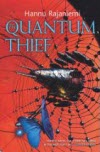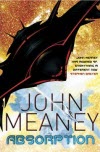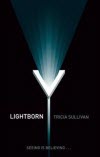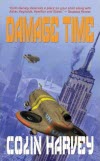Better Living Through Software
Cheryl Morgan finds recent science fiction releases share a common interest in the man-machine interface.
 Ever since the rise of cyberpunk in the 1980s (and quite possibly before then), science fiction has been obsessed with the relationship between the human brain and computers. There’s an argument that virtual worlds and nanotechnology have provided writers with the sort of magic wands that make modern day SF indistinguishable from fantasy, though personally I find a lot of it reminiscent of Michael Moorcock’s wonderful Dancers at the End of Time series [Purchase]. The important point, however, is not how you choose to classify subgenres, but whether the books are any good. Fortunately some of our finest writers are on the job.
Ever since the rise of cyberpunk in the 1980s (and quite possibly before then), science fiction has been obsessed with the relationship between the human brain and computers. There’s an argument that virtual worlds and nanotechnology have provided writers with the sort of magic wands that make modern day SF indistinguishable from fantasy, though personally I find a lot of it reminiscent of Michael Moorcock’s wonderful Dancers at the End of Time series [Purchase]. The important point, however, is not how you choose to classify subgenres, but whether the books are any good. Fortunately some of our finest writers are on the job.
 The idea that human minds might be uploaded into software has been around for quite a while. Charlie Stross’s Accelerando is one of the most famous uses of the idea. The new Iain M. Banks Culture novel, Surface Detail [Purchase], picks up the idea and runs with it. Suppose, Banks asks, this was possible. What would happen if fundamentalist religions got hold of this technology? That’s right, they would be able to make Heaven and Hell a reality. And Saint Peter would be redundant, because living people would decide who ended up where.
The idea that human minds might be uploaded into software has been around for quite a while. Charlie Stross’s Accelerando is one of the most famous uses of the idea. The new Iain M. Banks Culture novel, Surface Detail [Purchase], picks up the idea and runs with it. Suppose, Banks asks, this was possible. What would happen if fundamentalist religions got hold of this technology? That’s right, they would be able to make Heaven and Hell a reality. And Saint Peter would be redundant, because living people would decide who ended up where.
Of course The Culture would never do anything so dastardly as to condemn their citizens to Hell; not when they put so much effort into creating Heaven for the living. But they are not the only civilization in the galaxy. Some less evolved civilizations are very enthusiastic about “preserving local traditions”, especially those with authoritarian governments. Other civilizations are determined to stamp out the barbaric practice, but because all-out war is frowned upon in galactic society they agree to fight a proxy war in virtual worlds instead. The only trouble with such agreements, is that sooner or later one side has to face the fact that it is losing, and at that point they have to decide whether to escalate matters into the Real.
The plot of Surface Detail covers a wide range of characters including a corrupt businessman whose fortune is tied up with providing the server farms in which the Hells of the galaxy are hosted; two alien academics who brave their local Hell to find out how the dead are really treated; a Universal Soldier who fights in the virtual wars because being used as a weapon is all he knows how to do; and a Culture warship who is itching to actually use all of his lethal toys. I don’t need to tell you which of those characters steals the show.
 While Banks might still be one of the big stars of science fiction, there are plenty of young pretenders snapping at his heels. A book that people are tipping to carry off a few awards next year is The Quantum Thief [Purchase], a hugely impressive debut by Finnish writer, Hannu Rajaniemi. He also has characters spending time in virtual worlds after they die, but in the sophisticated far-future Mars of the novel death is only a temporary state that citizens go through in order to earn more time alive. While in the Quiet they work in the brains of the machines that keep the city of Oubliette running.
While Banks might still be one of the big stars of science fiction, there are plenty of young pretenders snapping at his heels. A book that people are tipping to carry off a few awards next year is The Quantum Thief [Purchase], a hugely impressive debut by Finnish writer, Hannu Rajaniemi. He also has characters spending time in virtual worlds after they die, but in the sophisticated far-future Mars of the novel death is only a temporary state that citizens go through in order to earn more time alive. While in the Quiet they work in the brains of the machines that keep the city of Oubliette running.
Much of the plot of The Quantum Thief involves a seemingly impossible crime. Isidore, a young man who fancies himself as a Consulting Detective, tries to solve the mystery. A prime suspect is the notorious thief, Jean le Flambeur, who has recently arrived on Mars having escaped the fearsome Dilemma Prison. Of course as le Flambeur is one of the main viewpoint characters, we know it can’t have been him that did it, unless of course it was something he planned and put in train before he went to prison and has since expunged from his memory. It is the sort of mystery that you can only do in science fiction.
Rajaniemi’s prose is excellent, and all the more impressive as English is not his native language. You may also have noticed quite a bit of French influence in the names. It helps to know a little French when reading the book. But it is the character of le Flambeur that will probably capture readers’ hearts. He’s the sort of loveable rogue that might have been played by David Niven in years past, and would doubtless be picked up by Robert Downey Jr. these days. The Quantum Thief is an explosive debut and I couldn’t be happier for Hannu.
 John Meaney has a rather different take on software life-after-death. His new SF novel, Absorption [Purchase], has a complex plot spanning many characters over several millennia. The characters include a Viking warrior, a Jewish lady physicist from Nazi Germany, and a mu-space pilot from the same far-future universe in which his Nulapeiron Sequence is set. The far-future action takes place in a tech-based city that bears some similarities to Rajaniemi’s Oubliette and Kathleen Ann Goonan’s Flower Cities, and here we encounter the fearsome concept of vampire code. Imagine that you are jacked in to the Internet, and someone comes through that interface and sucks out your mind, absorbing your skills and talents for themselves.
John Meaney has a rather different take on software life-after-death. His new SF novel, Absorption [Purchase], has a complex plot spanning many characters over several millennia. The characters include a Viking warrior, a Jewish lady physicist from Nazi Germany, and a mu-space pilot from the same far-future universe in which his Nulapeiron Sequence is set. The far-future action takes place in a tech-based city that bears some similarities to Rajaniemi’s Oubliette and Kathleen Ann Goonan’s Flower Cities, and here we encounter the fearsome concept of vampire code. Imagine that you are jacked in to the Internet, and someone comes through that interface and sucks out your mind, absorbing your skills and talents for themselves.
With so many viewpoints spread through space and time, the book takes a while to get started. It isn’t really until about half way through that you start to see the shape of the story. But the pace keeps accelerating as the book progresses and by the end we reach a breathless climax that leaves you itching for the next book in the series.
 A somewhat different take on the idea is provided by Tricia Sullivan’s Lightborn [Purchase]. In this novel a software system known as Lightborn, or colloquially Shine, is used to give viewers a more interactive and intense experience of popular media. It links you to your TV set, which by the time of the book is the same thing as your home computer. At the beginning of the book a rogue AI takes over the software and starts suborning viewers. It is more zombie code than vampire code, but alarming all the same, and by the time the software security guys manage to isolate the rogue a small American town has been taken over. Only the kids, who are too young for full-blown Shine connections, escape the AI’s control.
A somewhat different take on the idea is provided by Tricia Sullivan’s Lightborn [Purchase]. In this novel a software system known as Lightborn, or colloquially Shine, is used to give viewers a more interactive and intense experience of popular media. It links you to your TV set, which by the time of the book is the same thing as your home computer. At the beginning of the book a rogue AI takes over the software and starts suborning viewers. It is more zombie code than vampire code, but alarming all the same, and by the time the software security guys manage to isolate the rogue a small American town has been taken over. Only the kids, who are too young for full-blown Shine connections, escape the AI’s control.
A lot of authors would have written a book leading up to something like that, with the climax being the defeat of the AI. Sullivan is much braver. Her book is all about what happens after the event — to the people in the town, to the kids who managed to flee, and to America in general. The book reminded me in part of Sheri S. Tepper’s Raising the Stones, in which the population of a planet comes under the influence of a sentient fungus. Tepper is fairly happy about this, because the fungus puts an end to war and inequality; everyone is a happy part of the hive mind. Sullivan has a much more nuanced view of the possibilities, and therefore, to my mind, has produced a better book.
 Colin Harvey’s Damage Time [Purchase] is also much closer to our own world. Set in New York just a generation or so into the future, it too deals with the relationship between brains and software. The main character, Pete Shah, is a cop whose primary expertise is searching through recorded memories. In particular it is vital for the police to know if the memories they are studying are genuine or have been edited. But if memories can be recorded, so too can they be stolen and sold, and there you have an opportunity for organized crime.
Colin Harvey’s Damage Time [Purchase] is also much closer to our own world. Set in New York just a generation or so into the future, it too deals with the relationship between brains and software. The main character, Pete Shah, is a cop whose primary expertise is searching through recorded memories. In particular it is vital for the police to know if the memories they are studying are genuine or have been edited. But if memories can be recorded, so too can they be stolen and sold, and there you have an opportunity for organized crime.
Because he is dealing with the very near future, Harvey runs the risk of readers complaining “that couldn’t possibly happen.” For example, in the book, things like Peak Oil and Climate Change turn out to be real and not scurrilous lies put about by evil Liberals trying to deny good, upstanding Republicans their God-given right to unlimited consumption. Some people won’t like that. You might equally wonder whether California would really secede, build a wall to keep the rest of the country out, and proceed to uplift its citizens in nerd-like rapture to some early version of those Flower Cities. But Harvey isn’t really predicting here, he’s just postulating (see his interview in this issue for more on the background to the book). And who knows what will really happen in the future. I particularly like the bit where Shah, being a hard-bitten male cop, is thoroughly disrespectful towards a beautiful intersex woman, and then gets chewed out over his bigotry by his Imam.
 The real problem with memory, however, is that if you wait long enough it degrades horribly. That’s true whether it is stored in flesh, in software, or in history. Michael Moorcock’s Doctor Who novel, The Coming of the Terraphiles [Purchase], is set in the very far future when our Earth is more myth than history. The Terraphiles of the title are
The real problem with memory, however, is that if you wait long enough it degrades horribly. That’s true whether it is stored in flesh, in software, or in history. Michael Moorcock’s Doctor Who novel, The Coming of the Terraphiles [Purchase], is set in the very far future when our Earth is more myth than history. The Terraphiles of the title are Americans aliens who have developed an obsessive interest in English Terran history. So enthusiastic are they, that they create re-enactment theme parks worlds in which they can role-play the lives of the people they worship. That includes sporting events that merrily muddle archery, darts and cricket. In fact they get just about everything wrong, except perhaps that they all come over like characters out of a P.G. Wodehouse novel.
The Doctor, of course, is a bit of a Terraphile himself.
Moorcock fans will know that he has visited this sort of territory before – and for those who are not fans there is a clue at the beginning of this article. However, the Doctor is not exactly Jherek Carnelian, and Amy Pond is most definitely not Mrs. Amelia Underwood. Things are different this time around, and perhaps a little less funny.
Nevertheless, Moorcock manages to skewer both American re-enactors and the English upper classes at the same time. Much fun is had with an enormous, ugly hat that appears to be crowned with a particularly fearsome example of giant spider. The notorious space pirate, Captain Cornelius, takes an interest in proceedings, sailing the solar winds in a vessel that is a far better idea of a starjammer than anything that came out of a Shi’ar shipyard. The forces of obsessive Order are thwarted. Ordinary people mostly get to live happily ever after, and the TARDIS whisks the Doctor and Amy off into what they fervently hope will be the sunset but will probably end up being more deadly peril. Which just goes to show that Mr. Moorcock knows exactly what is required of a Doctor Who story.